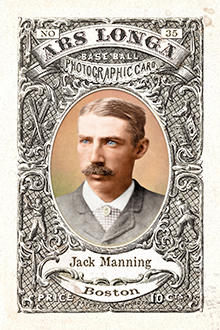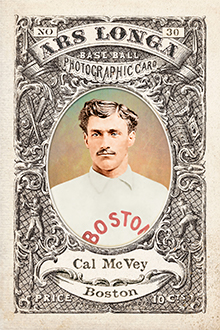
- Series: Pioneer Portraits I: 1850-1874
- City: Philadelphia
- Team: Athletics (NABBP)
- League: National Association (NAPBBP)
Fergus G. Malone (1844-1905) was a rare left-handed catcher, perhaps the first in major-league history (Bill Harbridge is another oft-cited contender for that title). Historians differ on what qualified then as a “major league,” but there is no doubt this Irishman was among the pioneers. He debuted with the Athletics in May, 1871 in the old National Association. A Civil War vet, Malone was a leader among his mates and was frequently tapped as “captain” or manager. He lasted in Philadelphia long enough for the new National League to form in 1876 while he was back with the Athletics. After a few seasons in the minors, Fergy got one last shot with the Union Association’s Philly Keystones in 1884 where a 19-year-old rookie named Jack Clements was starting out. Clements went on to be the most enduring and accomplished southpaw catcher in major league history.
- Fergy finished his time in pro ball managing Pennsylvania teams through 1888
- His batting average showed a downward arc probably related to the rigors of backstopping in the no-glove era: 1871 he hit .343, then .282, dropping steadily to .229 his last active season. Overall: .250

- Series: Pioneer Portraits I: 1850-1874
- City: Boston
- Team: Red Stockings (NAPBBP)
- League: National Association (NAPBBP)
John E. Manning (1853-1929) must have longed for his glory days on the mound in Boston while he played his last ML season in Baltimore in 1886. He achieved the dubious honor of being the best of the worst, leading or nearly leading the Orioles in most hitting categories during the most miserable offensive year of any team in baseball history. Manning had a fine career by that finale. He had helped the Red Caps to pennants in 1873, ’75 and ’78, hitting .266 in his rookie year and compiling a 35-7 record in the latter two championship years. Sadly, the versatile veteran went out on a sour note on the “Worst Hitting Team Ever.” The team’s BA was a lowly .204, plumbing depths of ineptitude that would never be exceeded by another franchise playing a full season.
- The modern MLB record for low BA was set by the Chicago White Stockings in 1910 (.210)
- On Oct 9, 1884 Manning became the 3rd player to hit 3 HRs in a game for the Quakers
- Series: Pioneer Portraits I: 1850-1874
- City: Boston
- Team: Red Stockings (NAPBBP)
- League: National Association (NAPBBP)
Calvin Alexander McVey (1849-1926) was a key player in the earliest days of pro ball, first with Harry Wright’s seminal Cincinnati Red Stockings in 1869, then moving with Wright to Boston as one of Harry’s select threesome. The young McVey joined the fledgling pro team for a stagecoach trip to Omaha and then became the 1st ball club to use the new transcontinental railroad to SF as part of the Red Stocking’s national tour.
- During his career, McVey played all nine positions and was an outstanding hitter: .346 BA lifetime
- McVey’s move from Boston to Chicago in 1876 with Al Spalding, Ross Barnes & Deacon White (to form the White Stockings with Cap Anson, Paul Hines & Bob Addy) led to the creation of the NL
- Series: Pioneer Portraits I: 1850-1874
- City: Philadelphia
- Team: Athletics (NABBP)
- League: National Association (NAPBBP)
Levi Samuel Meyerle (1849-1921) came up at the inception of the national game, playing in the National Association of Base Ball Players beginning in 1867 in Philadelphia. He made quite a mark in 1871 with the Athletics, hitting an astounding, league-best .492. In ‘73 Levi joined the city’s White Stockings club then went to Chicago’s team of the same name, reconstituted after a two-year hiatus due to the Great Fire. At every stop, Meyerle was a superb hitter. Again in ‘74 he led the league in batting. Over his career in early professional ball, Levi averaged .356 in eight seasons. He was able to play all positions, even pitching a few times, but excelled at first with his 6’1” stature.
- Meyerle was praised in his era not only for his skills with the bat but for “his quiet and gentlemanly deportment”
- Levi’s .492 mark has never been exceeded in any major league



